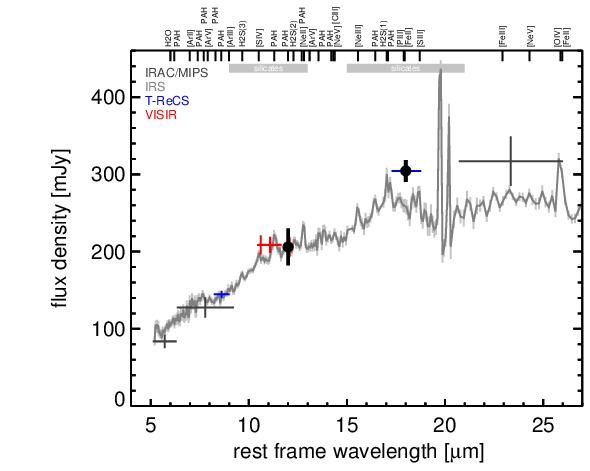Sasmirala Individual Information for NGC 6860
Description
NGC 6860 is an inclined barred spiral galaxy at a redshift of z = 0.0149 (D ~ 65.8 Mpc) with a Sy 1.5 nucleus [veron-cetty_catalogue_2010] and circum-nuclear star formation [lipari_high-resolution_1993]. It belongs to the nine-month BAT AGN sample and features nuclear east-west elongated [O III] emission (~ 6arcsec ~ 2 kpc; PA~ 90∘ [lipari_high-resolution_1993, schmitt_hubble_2003]). No high-angular resolution radio observations are described in the literature. NGC 6860 was first observed in the MIR with IRAS, which led to the discovery of its AGN. Follow-up observations were performed with Spitzer/IRAC, IRS and MIPS. The corresponding IRAC and MIPS images show a dominating compact nucleus embedded within weak host emission. Our nuclear IRAC photometry is significantly lower than the values published in [gallimore_infrared_2010] for unknown reasons. The IRS LR mapping-mode spectrum suffers from low S/N but indicates weak silicate 10 and 18 μm emission, weak PAH features, and a blue spectral slope in νFν-space (see also [buchanan_spitzer_2006, wu_spitzer/irs_2009, tommasin_spitzer-irs_2010]). Thus, the arcsecond-scale MIR SED appears to be marginally affected by star formation. The nuclear region of NGC 6860 was observed with T-ReCS in the Si2 and Qa filters in 2008 and 2007, respectively (unpublished, to our knowledge). In addition, we observed it with VISIR in three narrow N-band filters in 2009. A compact nucleus without further host emission was detected in all images, which is unresolved in all cases but Si2. However, the latter observations suffer from sub-average MIR seeing and, thus, we classify the nucleus of NGC 6860 as unresolved in the MIR. The nuclear photometry is consistent with the Spitzer spectrophotometry but has systematically ~ 6% higher flux levels. This might indicate slight flux variations between 2004 and 2009.
- [buchanan_spitzer_2006] Catherine L. Buchanan, Jack F. Gallimore, Christopher P. O'Dea, Stefi A. Baum, David J. Axon, Andrew Robinson, Moshe Elitzur, and Martin Elvis. Spitzer IRS spectra of a large sample of seyfert galaxies: A variety of infrared spectral energy distributions in the local active galactic nucleus population . AJ , 132 pp. 401–419, July 2006.
- [gallimore_infrared_2010] J. F. Gallimore, A. Yzaguirre, J. Jakoboski, M. J. Stevenosky, D. J. Axon, S. A. Baum, C. L. Buchanan, M. Elitzur, M. Elvis, C. P. O'Dea, and A. Robinson. Infrared spectral energy distributions of seyfert galaxies: Spitzer space telescope observations of the 12 μm sample of active galaxies . ApJS , 187 pp. 172–211, March 2010.
- [lipari_high-resolution_1993] Sebastian Lipari, Zlatan Tsvetanov, and F. Macchetto. High-resolution study of luminous infrared galaxies. i - the composite nature of the seyfert 1 galaxy IRAS 20044-6114 (NGC 6860) . ApJ , 405 pp. 186–198, March 1993.
- [schmitt_hubble_2003] H. R. Schmitt, J. L. Donley, R. R. J. Antonucci, J. B. Hutchings, and A. L. Kinney. A hubble space telescope survey of extended [o III] λ5007 emission in a far-infrared selected sample of seyfert galaxies: Observations . ApJS , 148 pp. 327–352, October 2003.
- [tommasin_spitzer-irs_2010] Silvia Tommasin, Luigi Spinoglio, Matthew A. Malkan, and Giovanni Fazio. Spitzer-IRS high-resolution spectroscopy of the 12 μm seyfert galaxies. II. results for the complete data set . ApJ , 709 pp. 1257–1283, February 2010.
- [veron-cetty_catalogue_2010] M.-P. Véron-Cetty and P. Véron. A catalogue of quasars and active nuclei: 13th edition . A&A , 518 pp. 10, July 2010.
- [wu_spitzer/irs_2009] Yanling Wu, Vassilis Charmandaris, Jiasheng Huang, Luigi Spinoglio, and Silvia Tommasin. Spitzer/IRS 5-35 μm low-resolution spectroscopy of the 12 μm seyfert sample . ApJ , 701 pp. 658–676, August 2009.
Images

Optical image (DSS, red filter). Displayed are the central 4 arcmin with North being up and East to the left. The colour scaling is linear with white corresponding to the median background (BG) and black to the 0.01% pixels with the highest intensity.

Spitzer MIR images. Displayed are the inner 40 arcsec with North being up and East to the left. The colour scaling is logarithmic with white corresponding to median BG and black to the 0.1% pixels with the highest intensity. The label in the bottom left states instrument and central wavelength of the filter in micron (I: IRAC, M: MIPS).

Subarcsecond-resolution MIR images sorted by increasing filter central wavelength. Displayed are the inner 4 arcsec with North being up and East to the left. The colour scaling is logarithmic with white corresponding to median BG and black to the 75% of the highest intensity of all images in units of sig_bg. The inset image (where present; either bottom or top right) shows the central arcsecond of the PSF from the calibrator star, scaled to match the science target. The labels in the bottom left state instrument and filter names (C: COMICS, M: Michelle, T: T-ReCS, V: VISIR).
SEDs


MIR SED. The description of the symbols in all the SED plots (where present) is the following: Grey crosses and solid lines mark the Spitzer/IRAC, MIPS and IRS data. The colour coding of the other symbols is as follows: green for COMICS, magenta for Michelle, blue for T-ReCS and red for VISIR data. Darker-coloured solid lines mark spectra of the corresponding instrument. The black filled circles mark the nuclear 12 and 18 micron continuum emission estimate from the data (where present). The ticks on the top axis mark positions of common MIR emission lines, while the light grey horizontal bars mark wavelength ranges affected by the silicate 10 and 18 micron features.